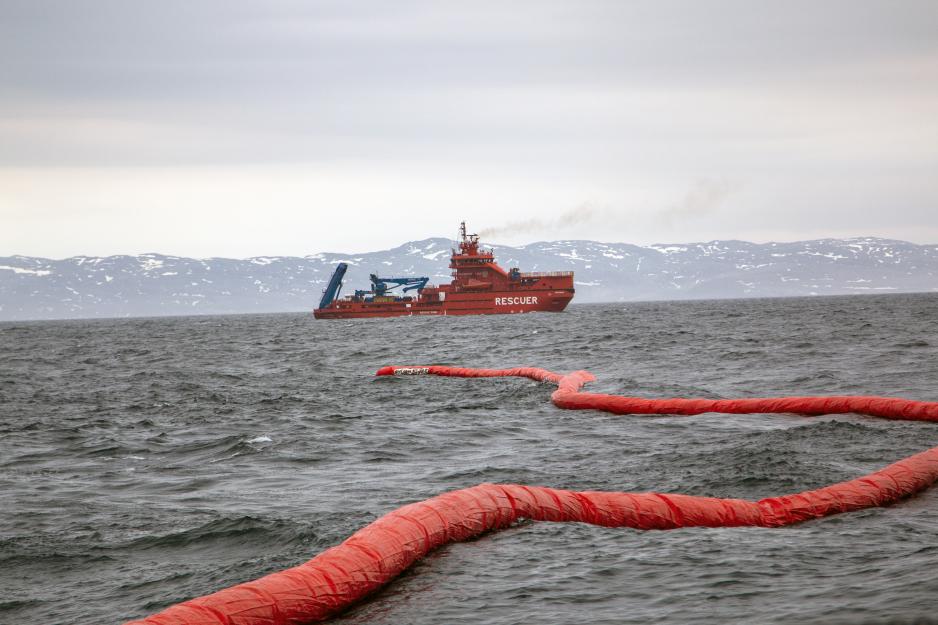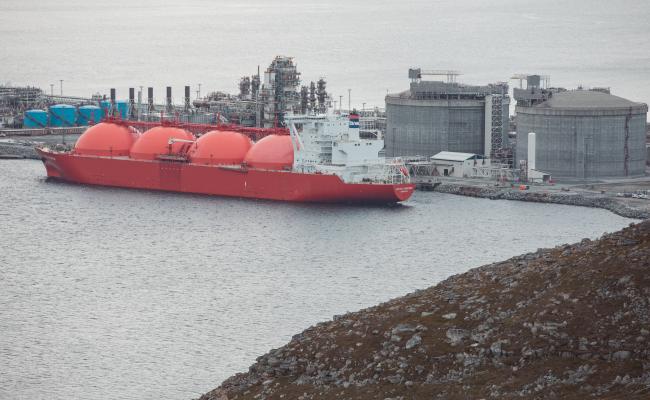Norway Against the Flow with Oil Drilling in the Arctic

The preparedness analysis shows that for parts of the year, there are obvious limitations in the efficiency of oil spill protection. There are major challenges when it comes to logistics and operational conditions, in particular with regard to year-round activity, the Norwegian Environmental Authority writes. (Photo from oil spill protection exercise Øvelse Barents 2019: Amund Trellevik)
“Using such large resources on opening fossil reserves that the world’s climate cannot take is completely insane”, says Truls Gulowen, Leader of Friends of the Earth Norway, about the Equinor plans about drilling for oil on the Wisting field.
Resistance against petroleum activity in the Arctic grows. US President Joe Biden announced in his climate plan that he wants a temporary ban on offshore drilling in the Arctic. Biden recently cancelled three planned oil and gas lease contracts in Alaska, a decision made in a challenging political landscape with soaring gas prices.
The EU also wants a ban on exploitation of oil and gas in the Arctic.
Yet Equinor wants to develop the world’s northernmost oil field, the Wisting field, located in the Norwegian part of the Barents Sea, some 300 kilometers off shore. The oil field was discovered in 2013 and lies further north than any other deposits of that size ever located before.
Against the flow
A potential production at the Wisting field would be a symbol of Norway’s going its own way, Friends of the Earth Norway Leader Truls Gulowsen points out to High North News.
“It would send a signal that Norway does not care what the rest of the world means, neither about the climate or about the Arctic”, he says.
If the Norwegian parliament Stortinget greenlights the development of this field, it will be able to produce oil for 30 years.
“This is new fossil fuel, almost exclusively oili, in the High Arctic, which will be very expensive. Infrastructure as well as operations will be expensive. If Norway nevertheless choses to operate this, that is simply a demonstration that one does not care about agreements signed or what others think about such an initiative”, Gulowsen adds.
Oil tax incentives
For a long time, it appeared that the Wisting development was not to happen. Then came the pandemic and with that, a tax subsidy for the oil industry was adopted by Stortinget. Thus, politicians secured profitability for the world’s northernmost oil field.
Now, the license is valid until May 2049.
However, in order to benefit from the oil tax incentive package, Equinor had to submit a plan for development and operations, as well as an impact assessment, by 2022. It has to be approved by 2023.
The hearing deadline for the impact assessment was in May.
In its hearing statement, the Norwegian Environmental Authority says that it is of the opinion that the impact assessment requirement for Wisting has not been met.
“We are of the opinion that Equinor has provided insufficient accounting for the challenges related to petroleum activities this far north. This includes a.o. environmental risk, preparedness against acute pollution, mitigating measures, and technology development needs. The NEA’s assessment is that there is no foundation for concluding that the Wisting development represents low environmental risk, as Equinor does in its impact assessment. The preparedness analysis shows that for parts of the year, there are obvious limitations on the efficiency of oil spill protection”, the NEA points out.
Using such large resources on opening fossil reserves that the world’s climate cannot take is completely insane
Environmental impact
“As indicated very clearly by the Environmental Authority’s hearing statement, the assessment is poor and the environmental risk is high”, Gulowsen says. He points in particular to the challenges related to operations on the well, such as fog, icing, darkness, frost, and other special weather challenges that occurs in this region.
There are challenges conditions if anything were to happen, while there is also a slightly higher risk of something occurring due to the weather conditions.
It is crucial to highlight the fact that there are large values nearby that can be hit, the FotE Norway adds. The direct environmental consequences are a.o. about the fact that a potential spill could reach the ice edge and Bjørnøya [Bear Island]. It would also hit the migrating route of the Arctic murre, stretching from Bjørnøya and into the Barents Sea.
“In addition, activity in the High Arctic, be it shipping or oil exploitation, will contribute to the overall pollution. Soot and black carbon contribute to melting in this region. This is an additional element that should lead to additional caution about activity this far north in the Arctic”, he says.

The Arctic murre, its looks resembling the common murre. Wisting is located in an important area for a series of bird species, the NEA writes. Accrding to SEA TRACK data, the swimming routes for common and Arctic murre go from Bjørnøya through the area in which installations are planned. In the swimming migration season (August-September) these birds are particularly at risk, as neither chicks nor adult birds are able to fly. (Photo: Verena Gill/USGS)
Oil tax incentives over climate
“From a climate perspective, using such large resources on opening fossil fuel reserves that the world cannot take in such a vulnerable aera is insane”, the FotE Norway leader says.
“Europe might need more Norwegian gas right now, however, no one will say there is a need for more Norwegian oil from a field in the Arctic in ten years.”
If the development is approved, the oil exported from it will account for 200 million tons of CO2 in climate gas emissions. That equals some 50 coal power plants on an annual basis, a series of environmental organizations, including FotE Norway, says in a joint hearing statement.
They argue that it is criticizable for Equinor not to have explored whether an approval of the Wisting field would be in keeping with the 1.5 degrees target.
They further point out that both the International Energy Agency (IEA) and the UN’s climate panel (UN-IPCC) are clear that approving the Wisting field would not be in keeping with the goal of the Paris Accord to limit global heating to a maximum of 1.5 degrees compared to pre-industrial times.
“The fact that EU countries have used up to 70 percent of their incentive packages during the Corona pandemic to climate transition is particularly interesting. In Norway, large parts of these funds have gone to the oil and gas industry. It is exactly the corona schemes with the oil tax incentives that have made this field relevant again. And there is an urgency about completing the process before the end of the year that escalates the environmental consequence issue”, Gulowsen says in closing.
The Arctic countries group
According to a report from the World Wide Fund for Nature’s Arctic program in collaboration with Vivid Economics, Norway is second-to last in the group in a comparison of the corona tax incentive packages of the Arctic countries, as well as of the effects on climate, environment, and new green jobs.
“This is an embarrassing position for Norway. This report shows how oil-dominated our economic Corona management has been, and how damaging it is to both the environment as well as to our own capacity to transform”, says Secretary General of WWF Norway Karoline Andaur.
“It is not like Norway has not don positive investments. On the contrary, the report refers to important measures such as support for green shipping and sustainable fisheries. However, this is too little and the climate effect of this initiative is completely overshadowed by the major tax incentives Parliament adopted for the oil industry this spring”, Andaur adds.
Due to the tax incentives, investments in oil and gas increased in 2020 compared to the year before.
“The community and nature will be the big losers when the rest of the world moves towards a zero-emission world. Our politicians should change the oil tax regime as soon as possible so that the companies have to take the brunt of the investment risk and to make investing in oil and gas less attractive”, Andaur says.
There is a need for a broad mix of energy, including oil and gas
Need for more energy sources
Norwegian Oil and Gas is an interest and employer organization for oil companies and suppliers related to oil activities on the Norwegian continental shelf. Regional Director Sigrid Ina Simonsen of Norwegian Oil and Gas, Section North says to High North News that the future will bring a need for a broad energy mix.
“Both the currently acute energy situation in Europe and also more long-term prognosis show that there is a need for a broad mix of energy, including oil and gas”, says Simonsen who speaks on general terms.
“We will then argue that it is important that this oil and gas are produced with as low emissions and costs as possible. There are good opportunities in the North for both developing new oil and gas projects that would provide jobs in a region desperately needing activity and income. Our industry also works actively on developing new value chains in ocean wind, hydrogen, as well as hydrogen capture and storage, which is highly topical in Europe and the rest of the world now. That can make energy from the Norwegian shelf competitive as an energy nation for decades to come”, the regional director says in closing.
Also read
This article was originally published in Norwegian and has been translated by HNN's Elisabeth Bergquist.






